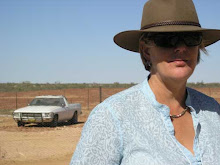
Neale the policeman finally opens the Birdsville Track for traffic.
At the beginning of March we were starting to develop cabin fever, after having been unable to get out of town because of the flooding for the last five weeks. As soon as the water went down enough for us to leave we drove down to Adelaide for a week just for a change of scenery. We knew there was a fourth flood coming, and hoped it would be up and down again quickly enough that we could get back in, but just in case, arranged for the flood boat to pick us up if necessary, and leave the truck on the other side. And necessary it was — it took nine days for the water to drop enough for us to go and get it back.
We finally got to drive all the way down the Birdsville Track. We stopped overnight at Mungerannie Hotel, a little pub next to a spring, with the Mungerannie Station homestead nearby. Pam the owner was lovely and looked after us very well, I think we were the first people she'd seen in days, it still being non-tourist season at that stage. The road itself was very good, but it was so hot we thought our air-conditioning had broken down until we opened the windows to find out. We realised how bad it would be to break down out here in these conditions, with little chance of someone happening by to help out. It reinforces the need to let people know where you're going, and letting them know when you get there.
There are a lot of ruins along the way, the most interesting being at Farina. There were several buildings, the town was finally deserted in the 1980s after the railway was closed, but once had a population of 300. I can't imagine how people used to live out here.

The ruins of the Mulka Homestead.

The ghost town of Farina. The Post Office finally closed in 1980.

The Lake Eyre Yacht Club. Not such a joke now, with all the water in Lake Eyre at the moment.
At last the scenery started changing, there were hills and trees, and the towns were closer together. After an excellent lunch at the pub at Parachilna, we detoured through the Flinders Ranges which was so foggy and rainy it was difficult to see anything. At the Clare Valley, I had to buy a jumper because when we left Birdsville it was so hot I didn't think to pack warm clothes. We stayed in a fabulous house overlooking the valley and enjoyed a bottle of wine in the spa bath, looking out at the blustery rain, thinking what a novelty it was to be cold again.

The scenery finally starts to change, although it is still a bit surreal. The (sealed!) road winds around naked hills south of Marree.

The Flinders Ranges was so overcast we didn't see much on our detour through after Parchilna.

This is the view of the Flinders on the way back north, the one most people see.

The view from the spa in the Clare Valley.
I'd earlier been looking on the internet job sites to see what sort of work might be available when we left Birdsville, and had spotted an ideal position in Broke, in the Hunter Valley, a couple of hours north of Sydney. We'd decided we loved Birdsville so much we would stay until after the next races in September, but the job was too good an opportunity to miss. After a couple of phone conversations, I agreed to do an overnight trip to Sydney for an interview once we arrived in Adelaide, which was successful. This threw a major spanner into our plans, I was due to start at the end of May. We were absolutely torn, our heads said what a great opportunity this was, our hearts said oh no, this means we'll have to leave soon! I was very excited at the new job, but it was going to be hard leaving Birdsville ...
By the time we drove back up the track to Birdsville, it all seemed a long way away — we still had three months to go, we would make the most of it. We radioed the flood boat guys and stashed the car at the race track. There was a welcome party in the boat when it arrived, it was a real homecoming. We stowed our belongings in the boat and headed back to town.
---
I'll put some more up shortly from what I can remeber, but it seems so long ago now. I'm dying to get back out to Birdsville, but circumstances so far have prevented it. Evan managed to get out there for the last Races, and for the Bronco Branding -- the National Titles were held there in May. And to the Drovers Festival in Camoweel -- his latest book, called The Drovers -- Stories behind the heroes of our stock routes was released recently and is a very good read -- not that I'm biased!













